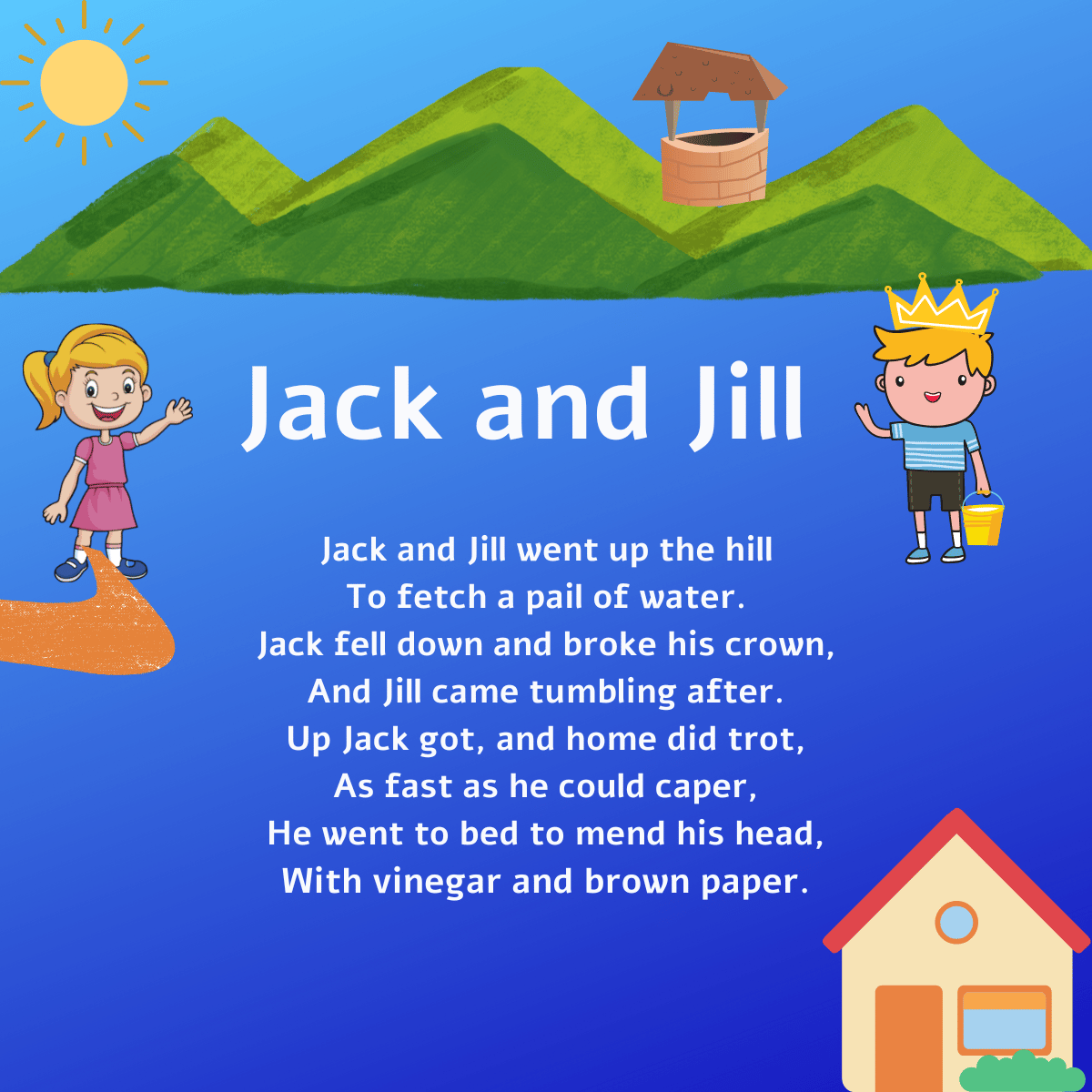Jack plus Jill: This seemingly simple nursery rhyme holds surprising depth. From its historical origins and evolving interpretations to its enduring archetypal characters and enduring themes of ambition, failure, and collaboration, “Jack and Jill” offers a rich tapestry for exploration. This analysis delves into the rhyme’s multifaceted nature, examining its cultural significance, symbolic meaning, and lasting impact on storytelling and literature.
We will explore various interpretations of the rhyme, considering its potential moral messages and how its meaning can shift depending on the age and cultural background of the reader. We will also analyze the archetypal roles of Jack and Jill, comparing their personalities and exploring the psychological implications of their actions. Finally, we’ll consider creative extensions, such as sequels, plays, and songs, demonstrating the enduring power and adaptability of this classic children’s rhyme.
The Nursery Rhyme “Jack and Jill”
The seemingly simple rhyme of “Jack and Jill” holds a surprising depth of historical context and interpretive possibilities. Its enduring popularity across centuries and cultures highlights its resonance with universal themes and anxieties. While the precise origins remain elusive, its enduring legacy makes it a rich subject for analysis.
Historical Context and Variations of “Jack and Jill”
The earliest known printed version of “Jack and Jill” dates back to the 18th century, though oral traditions suggest a much older provenance. Variations abound, with some versions focusing on the comedic fall, others hinting at darker undertones. Some versions replace the water pail with other objects, altering the narrative’s focus. The rhyme’s evolution reflects societal shifts and changing interpretations of its underlying meaning.
For example, some interpretations link the rhyme to the French Revolution, while others connect it to medieval folklore. The lack of definitive historical evidence allows for multiple, compelling interpretations.
Symbolism in “Jack and Jill”
The symbolism within “Jack and Jill” is multifaceted and open to interpretation. The hill itself can represent life’s journey, with the ascent symbolizing ambition or pursuit of a goal, and the fall representing setbacks or failures. The water, traditionally associated with life and sustenance, might symbolize the pursuit of knowledge or essential resources. Jack and Jill, as archetypal figures, can represent the common person’s struggle with hardship and resilience.
Different interpretations emphasize various aspects of this symbolism, creating a rich tapestry of meaning. Some view it as a simple cautionary tale about reckless behavior, while others see it as a metaphor for the human condition.
Comparative Analysis of Versions Across Cultures and Time Periods
While the core narrative remains consistent across various versions, subtle differences highlight cultural nuances. In some cultures, the focus shifts from the physical fall to the emotional or societal consequences of the characters’ actions. The rhyme’s adaptation into different languages further demonstrates its adaptability and cultural significance. For example, the imagery and tone might be subtly adjusted to resonate with the specific cultural context of each translation.
These variations reveal how a seemingly simple children’s rhyme can reflect and adapt to different social and cultural landscapes.
A Modernized Version of “Jack and Jill”
Jack and Jill, with backpacks bright,Climbed the data hill with all their might.For knowledge sought, they reached the peak,But stumbled down, a digital leak!Their files corrupted, dreams undone,They learned a lesson, a valuable one:Backups are key, and plans well-made,To conquer challenges, unafraid.
Visual Representation for Children’s Literature
A vibrant illustration could depict Jack and Jill as cheerful children, perhaps with slightly clumsy expressions. They could be climbing a brightly colored, whimsical hill, rendered in a style reminiscent of classic children’s book illustrations. The hill itself could be teeming with friendly woodland creatures, adding to the lighthearted tone. Jack and Jill could be carrying a modern, sleek water bottle instead of a traditional pail, subtly updating the image while retaining the core essence of the rhyme.
The overall aesthetic should be bright, cheerful, and engaging, inviting children to connect with the characters and the story. The background could include a bright blue sky, fluffy clouds, and perhaps a small village in the distance. The scene would be carefully composed to create a sense of movement and energy, reflecting the dynamism of the children’s climb.
The style could be similar to that of Beatrix Potter or other classic illustrators, using bold colors and simple lines to create a captivating image.
Interpretations and Themes: Jack Plus Jill

The seemingly simple nursery rhyme “Jack and Jill” offers a surprising depth of interpretation, lending itself to various readings depending on the age and perspective of the interpreter. Its brevity belies a richness of themes that have resonated across generations and cultures. This section will explore some of these interpretations and themes, examining how the rhyme has been used and understood in different contexts.
Moral and Message Interpretations, Jack plus jill
The rhyme’s moral message is open to interpretation. Some view it as a cautionary tale about the dangers of ambition and the consequences of reckless pursuit of goals, represented by Jack and Jill’s ill-fated trip to fetch water. The fall can symbolize the pitfalls of unchecked ambition or the inherent risks in collaborative endeavors. Others see it as a commentary on the nature of childhood play, where accidents and setbacks are common occurrences.
Still others might focus on the collaborative aspect, highlighting the importance of teamwork, even if the outcome is ultimately unsuccessful. The lack of explicit moralizing allows for a multiplicity of readings, making it adaptable to various pedagogical approaches.
Contextual Uses of “Jack and Jill”
“Jack and Jill” has transcended its origins as a simple rhyme. It has been used extensively in educational settings to teach basic literacy skills, particularly rhyme and rhythm. Its repetitive structure makes it ideal for young children learning to read and speak. In advertising, the rhyme’s familiarity has been leveraged to create memorable slogans and jingles. The simplicity and memorability of the rhyme make it a valuable tool in marketing, easily embedding itself in the consumer’s mind.
The rhyme’s imagery has also inspired artwork and illustrations, further extending its reach and impact across various media.
Themes of Ambition, Failure, and Collaboration
The rhyme subtly explores the themes of ambition, failure, and collaboration. Jack and Jill’s journey to the hill represents ambition – their desire to obtain water. Their subsequent fall embodies failure, highlighting the unpredictable nature of pursuing goals. However, the fact that they embark on this quest together emphasizes the theme of collaboration, albeit a collaboration that ends unsuccessfully.
This interplay of ambition, failure, and collaboration creates a nuanced narrative that encourages reflection on the complexities of human endeavor.
Age and Cultural Interpretations
A child might focus on the literal aspects of the rhyme – the climb, the fall, and the pain. An older child or adult might delve deeper into the allegorical meanings, exploring the themes of ambition, risk, and the consequences of actions. Cultural contexts also influence interpretation. In some cultures, the emphasis might be on the communal aspect of fetching water, highlighting the importance of shared responsibility.
In others, the focus might be on the individual’s responsibility for their actions. These varied interpretations underscore the enduring appeal and adaptability of the rhyme.
Teaching Responsibility and Consequences
A short story illustrating the rhyme’s lesson on responsibility and consequences could focus on two children, Lily and Tom, who decide to climb a steep hill to collect berries without telling their parents. Their ambition leads them to a dangerous situation, mirroring Jack and Jill’s fall. The story could then detail the consequences of their actions – scraped knees, a scolding from their parents, and the understanding that they should have asked for permission and taken necessary precautions.
This reinforces the idea that actions have consequences, even in seemingly simple activities, and highlights the importance of responsibility and careful planning.
In conclusion, the seemingly simple tale of Jack and Jill reveals a complexity that transcends its childish simplicity. Through exploring its historical context, symbolic interpretations, and archetypal characters, we uncover a narrative that resonates across cultures and generations. Its enduring popularity speaks to its ability to explore universal themes of ambition, collaboration, and the consequences of our actions, making it a timeless piece of children’s literature worthy of continued study and reinterpretation.
Enhance your insight with the methods and methods of zillow atlanta ga.



